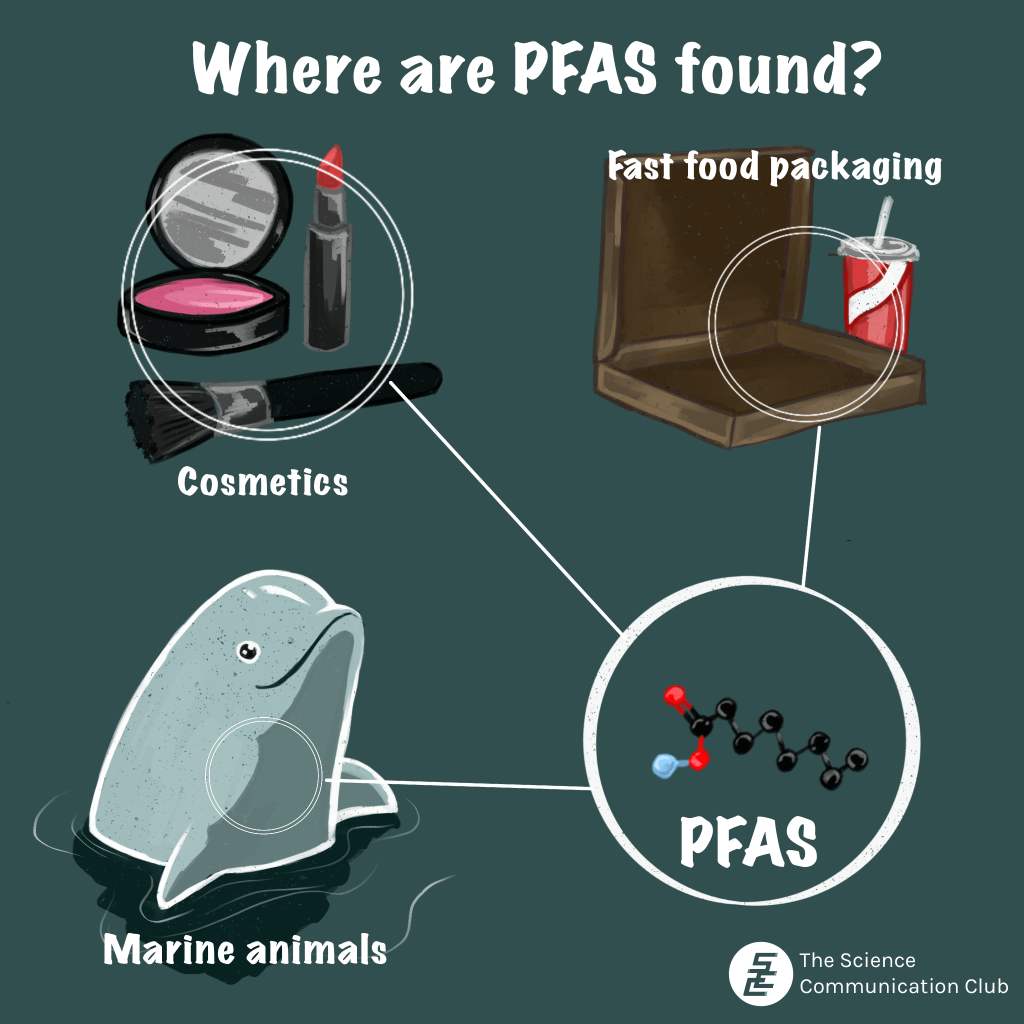
Written by Angie Lo
Illustrated by Juliet Ko
Earlier this year in the US, a lawsuit was taken against the popular juice product Simply Tropical for containing levels of dangerous chemicals called PFAS. It turns out that these chemicals were at levels “hundreds of times” greater than the US Environmental Protection Agency’s advisory limits for drinking water1. PFAS, also known as “forever chemicals”, are associated with a multitude of health problems, including high cholesterol, thyroid disease, and increased risk of kidney and testicular cancer2. The uglier truth is that these chemicals are found in more places than you’d think–and they’re extremely hard to get rid of. But what exactly are PFAS, and how deeply do their harmful impacts reach?
PFAS are a class of synthetic compounds with a unique chemical structure. They are amphiphilic, meaning that some parts of their structure repel water, while other parts repel fats such as oil. They’re also characterized by multiple bonds of carbon and fluorine, which are extremely strong and allow PFAS to remain stable under high temperatures. Because of this, they’ve been used for decades in a huge variety of heat-resistant, waterproof, and grease-proof items, ranging from welding materials and construction sealants to fast-food packaging and cosmetics3.
However, the strength of PFAS’ carbon-fluorine bonds means that PFAS are extremely resistant to breakdown4, earning them their infamous nickname “forever chemicals”5. When PFAS get leached into the environment—such as through air or water emissions during industrial production of PFAS-containing products, or through the disposal of these products into landfills—they stay there for a long time5. PFAS can later enter the bodies of humans and animals if they consume water or breathe in air contaminated by the chemicals2. Contact with certain consumer products or eating other animals which are contaminated can also cause PFAS to accumulate in bodies6.
As said before, PFAS are linked to a multitude of health problems. Besides the problems described above, evidence shows that PFAS are also associated with even more varied problems concerning different human body systems, such as increased risk of miscarriage7 and decreased responses to vaccines in children2. Courtney Caringan, an environmental epidemiologist at Michigan State University, says: “It seems that the property that makes them useful — that they’re very persistent and they have this one part of them that really likes water and the other part that does not — also seems to be what makes them problematic in the body.”2
There are some instances where using PFAS is necessary—such as when there’s no other substitute for it in a product that’s crucially needed. But there are plenty of instances where experts say PFAS are not necessary, such as in many consumer products2.

In Canada, three groups of PFAS—PFOS, PFOA and LC-PFCAs—which are known to be associated with health and environmental risks, are banned8. But in manufacturing, they are likely to be replaced with other types of PFAS. Unlike the three groups described above, they haven’t been as thoroughly studied, and we’re less knowledgeable about the health risks4. Even so, there’s still the possibility of dangers4—and Health Canada says there’s evidence that some of the substitutes have already been found to be associated with environmental and health effects8. Because of this, Canada’s government is considering taking a “precautionary principle” where PFAS are treated as an entire class, rather than on a group basis8. According to their website, they’re currently “collect[ing] and examin[ing] information on PFAS to inform a class-based approach,” with a report on the state of PFAS expected to come out sometime this year9.
People living in northern regions of Canada who depend on wild food are disproportionately at risk, as animals such as seals and belugas have high levels of accumulated PFAS4. Studies have shown that for some types of PFAS, those living in northern regions have levels twice to several times higher than those living elsewhere in Canada4,6,10.
“What’s going on in the industrialized nations is having a direct impact on us, on our food, and we are consuming the contaminants. It’s on our dinner plates,” said Lucy Grey4, former Inuit research adviser for the Kativik Regional Government in northern Quebec10.
“People were saying, ‘Stop eating the belugas.’ But you can’t really do that either, because now you’re taking away the nutritional value,” she continued. “And understand the importance, culturally and traditionally. Then you’re going to replace it with what? Store-bought foods that are very expensive?”4
Because of this issue, some scientists are calling for more stringent regulations to reduce the exposure of those who live in northern regions to PFAS6. Lucy Grey worked with other Inuit people from her home region of Nunavik, scientists from Quebec’s University of Laval, and several other researchers to create a report outlining the presence and potential risks of PFAS in Nunavik Inuit. She and the UofLaval scientists presented their findings at the Stockholm Convention on Persistent Organic Pollutants, calling for the global ban of PFAS as a class10.
What can we do about the PFAS problem as individuals? One thing we can do every day is be more conscious: swap disposable food packaging for reusable containers, for instance. Looking for PFAS-free products is a greater challenge, though, since many times product labels aren’t clear as to whether or not they contain it2,8. Some recommendations include avoiding waterproof or long-lasting cosmetics in general7 and avoiding stain-resistant clothes and textiles11. We can also spread the message around to raise awareness—every bit of collective action counts.
Sources
- Perkins T. ‘All-natural’ Simply Tropical juice has high toxic PFAS levels, lawsuit alleges. The Guardian. 2023 Jan 25. Available from: https://www.theguardian.com/environment/2023/jan/19/simply-orange-juice-coca-cola-pfas-class-action-lawsuit
- Isaacs-Thomas B. Why getting PFAS out of our products is so hard – and why it matters. PBS Newshour. 2022 Sep 28 [accessed 2023 Feb 7]. https://www.pbs.org/newshour/science/pfas-are-everywhere-what-can-we-do-to-change-that
- Panieri E, Baralic K, Djukic-Cosic D, Buha Djordjevic A, Saso L. Pfas Molecules: A Major Concern for the Human Health and the Environment. Toxics. 2022;10(44). doi:10.3390/toxics10020044
- Weikle B, Buyting S. ‘forever chemicals’ can have far-reaching consequences, need more regulation in Canada, scientists say | CBC radio. CBC Radio. 2020 Nov 7 [accessed 2023 Feb 7]. https://www.cbc.ca/radio/quirks/nov-7-fast-radio-bursts-in-our-galaxy-monkeys-with-a-puberty-switch-and-more-1.5789388/forever-chemicals-can-have-far-reaching-consequences-need-more-regulation-in-canada-scientists-say-1.5789395
- Brennan NM, Evans AT, Fritz MK, Peak SA, von Holst HE. Trends in the Regulation of Per- and Polyfluoroalkyl Substances (PFAS): A Scoping Review. International Journal of Environmental Research and Public Health. 2021;18(20):10900. doi:10.3390/ijerph182010900
- Ratelle M, Garcia-Barrios J. Toxic, long-lasting contaminants detected in people living in northern Canada. The Conversation. 2022 Nov 4 [accessed 2023 Feb 7]. https://theconversation.com/toxic-long-lasting-contaminants-detected-in-people-living-in-northern-canada-141256
- Emerging chemical risks in Europe – ‘PFAS’. European Environment Agency. 2019 Dec 12 [accessed 2023 Feb 15]. https://www.eea.europa.eu/publications/emerging-chemical-risks-in-europe
- Chung E, Hopton A, Singh I. How to make sense of the new findings on ‘forever chemicals’ in makeup. CBC News. 2021 Jun 16 [accessed 2023 Feb 7]. https://www.cbc.ca/news/science/cosmetics-pfas-faq-1.6066147
- Government of Canada. Per- and polyfluoroalkyl substances (PFAS). Government of Canada. [updated 2021 Jul 29; accessed 2023 Feb 7]. https://www.canada.ca/en/health-canada/services/chemical-substances/other-chemical-substances-interest/per-polyfluoroalkyl-substances.html
- Hendrie S. Inuit help ban “forever chemicals”. Makivvik. 2022 Oct 7 [accessed 2023 Feb 7]. https://www.makivik.org/article/inuit-help-ban-forever-chemicals/
- Toxic-Free Future. PFAS “Forever Chemicals” . Toxic-Free Future. [accessed 2023 Feb 7]. https://toxicfreefuture.org/toxic-chemicals/pfas-forever-chemicals/